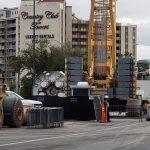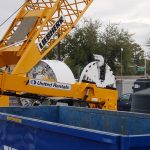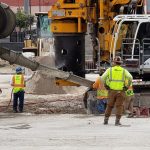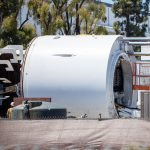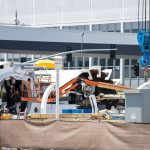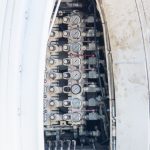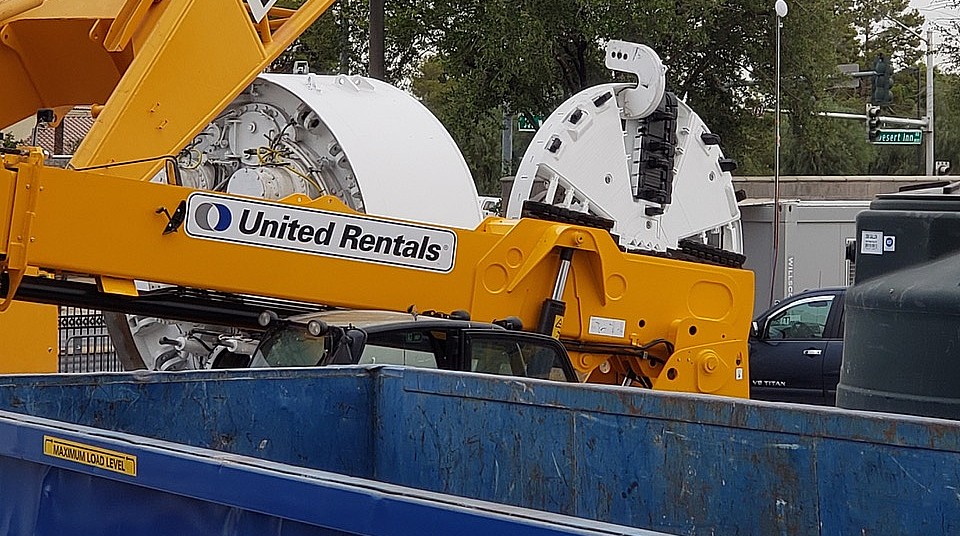
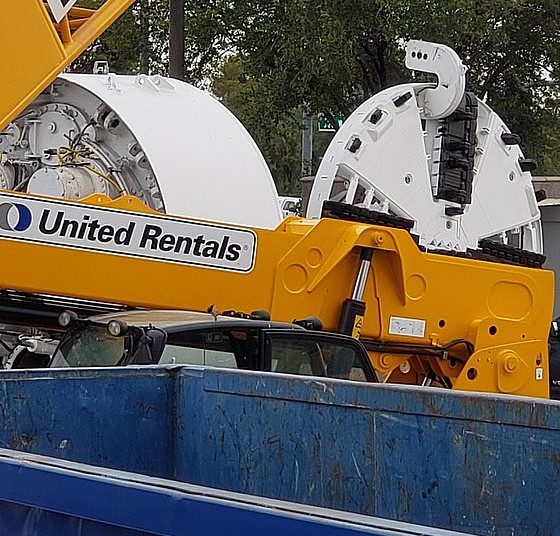
News
The Boring Company’s Las Vegas Loop tunnel project is coming to life
The Boring Company’s upcoming Loop project at the Las Vegas Convention Center appears to be coming to life, with the first images of the startup’s dig site emerging online. Images that have emerged of the startup’s activities reveal that The Boring Company has started shipping parts of a tunnel boring machine to Las Vegas, with a TBM cutter head and mixing chamber recently arriving at the location.
Initial pictures of The Boring Company’s activities were shared on Twitter last week, courtesy of @JamesInLasVegas. The photos depicted heavy machinery surrounding the tunneling startup’s dig site, including several cranes and what appeared to be a pile driver. An image of a tunnel boring machine’s cutter head was also posted.
Elon Musk's tunnel project at the Las Vegas Convention Center just went from WTF to OMFG. (via @JamesInLasVegas) @elonmusk @boringcompany pic.twitter.com/qTqgDZN8J3
— Vital Vegas (@VitalVegas) September 18, 2019
A source familiar with the Boring Company’s current activities for the Las Vegas Convention Center Loop project recently informed Teslarati that the startup’s activities have started ramping over the past few weeks. The source, who has asked to remain anonymous, added that The Boring Company has been granted a pit permit, and thus, the startup has started the construction of a secant wall for the Loop system’s passenger station located on the east end of the LVCC’s South Hall.
Similar to the initial Twitter posts that emerged of the ongoing project, the source also mentioned that parts of a tunnel boring machine started arriving Thursday night. First was what appeared to be a brand new cutter head, followed by a mixing chamber. Both these TBM parts were dropped off at a location that was visible from Desert Inn Blvd.
The Boring Company’s tunnel boring machine segments arrive at the Las Vegas site.
Interestingly, the secant wall is reportedly progressing quickly, and once this is done, excavation will soon follow. Overall, the Las Vegas Convention Center Loop appears to be progressing well, though hitting Elon Musk’s goal of completing the Loop system by the end of 2019 will likely remain a challenging task. But if the company’s digging technology is up for the challenge, the Tesla and SpaceX CEO’s timetable will likely prove feasible.
Much of the details about The Boring Company’s tunneling plans for the Las Vegas Loop system are yet to be announced. Perhaps the biggest question right now is if the startup will be deploying its next-generation TBM for the project. The Boring Company’s Hawthorne test tunnel was built using Godot, a conventional tunnel boring machine. Elon Musk has since announced that the startup is working on two new machines, a hybrid TBM named Line-Storm, which is capable of digging around twice as fast as Godot, and Prufrock, an all-electric TBM that can dig around 10-15 times faster than a conventional tunneling machine, with very little noise and zero emissions.
- The Boring Company works on a tunnel boring machine. (Credit: Teslarati)
- The Boring Company works on a tunnel boring machine.
- The Boring Company works on a tunnel boring machine.
The Boring Company works on a tunnel boring machine.
Images of what appeared to be a new TBM being assembled at the tunneling startup’s lot in the vicinity of the SpaceX headquarters in Hawthorne have been captured a few months ago. With this in mind, there seems to be a good chance that The Boring Company’s Las Vegas project could utilize one of the startup’s newer machines. Perhaps The Boring Company will play it safe and deploy Godot, which has already been tried and tested at Hawthorne, or perhaps the startup could utilize Line-Storm or Prufrock to complete the project faster.

News
Tesla FSD fleet is nearing 7 billion total miles, including 2.5 billion city miles
As can be seen on Tesla’s official FSD webpage, vehicles equipped with the system have now navigated over 6.99 billion miles.

Tesla’s Full Self-Driving (Supervised) fleet is closing in on almost 7 billion total miles driven, as per data posted by the company on its official FSD webpage.
These figures hint at the massive scale of data fueling Tesla’s rapid FSD improvements, which have been quite notable as of late.
FSD mileage milestones
As can be seen on Tesla’s official FSD webpage, vehicles equipped with the system have now navigated over 6.99 billion miles. Tesla owner and avid FSD tester Whole Mars Catalog also shared a screenshot indicating that from the nearly 7 billion miles traveled by the FSD fleet, more than 2.5 billion miles were driven inside cities.
City miles are particularly valuable for complex urban scenarios like unprotected turns, pedestrian interactions, and traffic lights. This is also the difference-maker for FSD, as only complex solutions, such as Waymo’s self-driving taxis, operate similarly on inner-city streets. And even then, incidents such as the San Francisco blackouts have proven challenging for sensor-rich vehicles like Waymos.
Tesla’s data edge
Tesla has a number of advantages in the autonomous vehicle sector, one of which is the size of its fleet and the number of vehicles training FSD on real-world roads. Tesla’s nearly 7 billion FSD miles then allow the company to roll out updates that make its vehicles behave like they are being driven by experienced drivers, even if they are operating on their own.
So notable are Tesla’s improvements to FSD that NVIDIA Director of Robotics Jim Fan, after experiencing FSD v14, noted that the system is the first AI that passes what he described as a “Physical Turing Test.”
“Despite knowing exactly how robot learning works, I still find it magical watching the steering wheel turn by itself. First it feels surreal, next it becomes routine. Then, like the smartphone, taking it away actively hurts. This is how humanity gets rewired and glued to god-like technologies,” Fan wrote in a post on X.
News
Tesla starts showing how FSD will change lives in Europe
Local officials tested the system on narrow country roads and were impressed by FSD’s smooth, human-like driving, with some calling the service a game-changer for everyday life in areas that are far from urban centers.

Tesla has launched Europe’s first public shuttle service using Full Self-Driving (Supervised) in the rural Eifelkreis Bitburg-Prüm region of Germany, demonstrating how the technology can restore independence and mobility for people who struggle with limited transport options.
Local officials tested the system on narrow country roads and were impressed by FSD’s smooth, human-like driving, with some calling the service a game-changer for everyday life in areas that are far from urban centers.
Officials see real impact on rural residents
Arzfeld Mayor Johannes Kuhl and District Administrator Andreas Kruppert personally tested the Tesla shuttle service. This allowed them to see just how well FSD navigated winding lanes and rural roads confidently. Kruppert said, “Autonomous driving sounds like science fiction to many, but we simply see here that it works totally well in rural regions too.” Kuhl, for his part, also noted that FSD “feels like a very experienced driver.”
The pilot complements the area’s “Citizen Bus” program, which provides on-demand rides for elderly residents who can no longer drive themselves. Tesla Europe shared a video of a demonstration of the service, highlighting how FSD gives people their freedom back, even in places where public transport is not as prevalent.
What the Ministry for Economic Affairs and Transport says
Rhineland-Palatinate’s Minister Daniela Schmitt supported the project, praising the collaboration that made this “first of its kind in Europe” possible. As per the ministry, the rural rollout for the service shows FSD’s potential beyond major cities, and it delivers tangible benefits like grocery runs, doctor visits, and social connections for isolated residents.
“Reliable and flexible mobility is especially vital in rural areas. With the launch of a shuttle service using self-driving vehicles (FSD supervised) by Tesla in the Eifelkreis Bitburg-Prüm, an innovative pilot project is now getting underway that complements local community bus services. It is the first project of its kind in Europe.
“The result is a real gain for rural mobility: greater accessibility, more flexibility and tangible benefits for everyday life. A strong signal for innovation, cooperation and future-oriented mobility beyond urban centers,” the ministry wrote in a LinkedIn post.
News
Tesla China quietly posts Robotaxi-related job listing
Tesla China is currently seeking a Low Voltage Electrical Engineer to work on circuit board design for the company’s autonomous vehicles.

Tesla has posted a new job listing in Shanghai explicitly tied to its Robotaxi program, fueling speculation that the company is preparing to launch its dedicated autonomous ride-hailing service in China.
As noted in the listing, Tesla China is currently seeking a Low Voltage Electrical Engineer to work on circuit board design for the company’s autonomous vehicles.
Robotaxi-specific role
The listing, which was shared on social media platform X by industry watcher @tslaming, suggested that Tesla China is looking to fill the role urgently. The job listing itself specifically mentions that the person hired for the role will be working on the Low Voltage Hardware team, which would design the circuit boards that would serve as the nervous system of the Robotaxi.
Key tasks for the role, as indicated in the job listing, include collaboration with PCB layout, firmware, mechanical, program management, and validation teams, among other responsibilities. The role is based in Shanghai.
China Robotaxi launch
China represents a massive potential market for robotaxis, with its dense urban centers and supportive policies in select cities. Tesla has limited permission to roll out FSD in the country, though despite this, its vehicles have been hailed as among the best in the market when it comes to autonomous features. So far, at least, it appears that China supports Tesla’s FSD and Robotaxi rollout.
This was hinted at in November, when Tesla brought the Cybercab to the 8th China International Import Expo (CIIE) in Shanghai, marking the first time that the autonomous two-seater was brought to the Asia-Pacific region. The vehicle, despite not having a release date in China, received a significant amount of interest among the event’s attendees.
